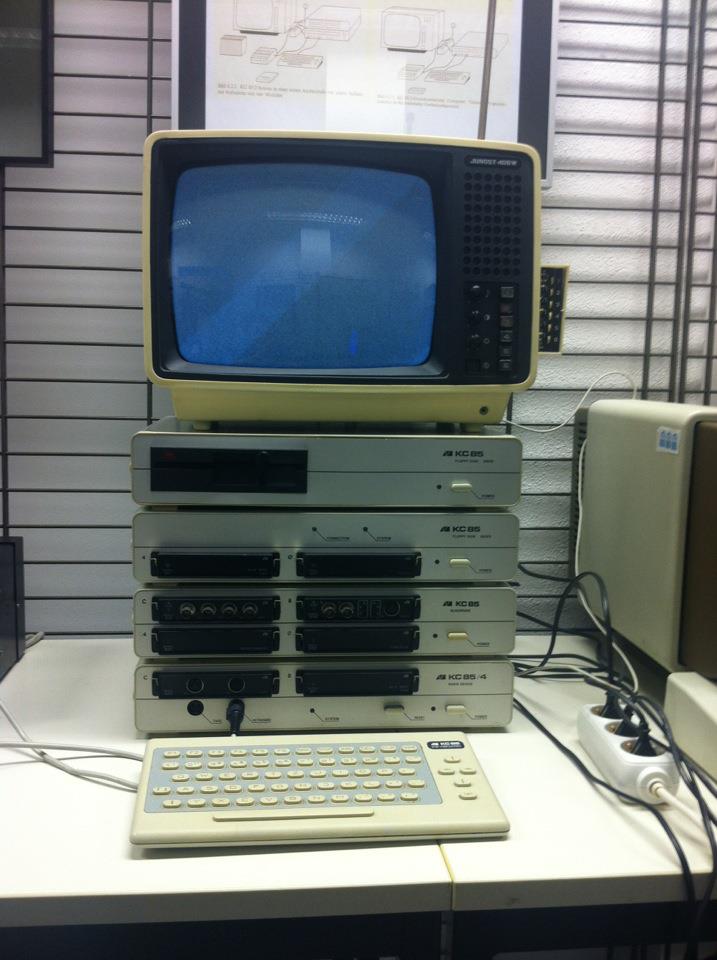The KC85 Computer Series
The KC85 was a series of 8-bit computers built in Eastern Germany during the 1980’s.
KC means ‘Kleincomputer’ or ‘Small Computer’, this was an umbrella name for 6 different computer models with partially very different hardware designs and from 2 different manufacturers:
- KC85/2 (originally HC-900), KC85/3, KC85/4: this is the KC ‘main-line’ built by the VEB Mikroelektronikkombinat Mühlhausen
- KC85/1 (originally Z9001), KC87: the Z9001 and its successor the KC87 were built by Robotron Dresden, they had a different hardware architecture and were incompatible with the KC85/2-based mainline
- KC Compact: this was an Amstrad CPC clone from Mühlhausen and came out too late to make any impact
The KC85/2 and its successors were the most interesting machines, because they had a unique hardware and operating system design, detailed below. From here on, the name ‘KC85’ will be used for the KC85/2, /3 and /4 line of computers only.
This is a KC85/3 at the Vintage Computing Festival 2015 in Berlin with a fairly mysterious floppy disk expansion prototype on top:

And at the same event, a KC85/4 with a breadboard expansion module and a thematically matching cassette tape recorder (the computer in the background is an Atari 800XL if I’m not mistaken):

Hardware Specs
All computers of the KC85/2 line were based on the U880 CPU (an ‘unlicensed’ Z80 clone) running at 1.75 MHz or 1.77 MHz and didn’t have any custom chips for video or audio. The closest western 8-bit homecomputer was probably the ZX Spectrum, which also didn’t have custom chips, had a similar video memory organisation, but was running twice as fast at 3.5 MHz.
All KC85 models could display 320x256 pixels at 16 foreground and 8 background colors, but with limited color resolution: a block of 8x4 pixels could be assigned one foreground and one background color.
The color resolution was greatly improved in the KC85/4 to 8x1 pixels.
The KC85 models differed most in their RAM configuration:
- KC85/2:
- 16 KByte general RAM
- 16 KByte video RAM
- 4 KByte operating system ROM
- KC85/3: same RAM config as KC85/2 but
more ROM and a built-in BASIC interpreter:
- 16 KByte general RAM
- 16 KByte video RAM
- 8 KByte BASIC ROM
- 8 KByte OS ROM
- KC85/4: the 85/4 was a true memory monster with 128 KByte RAM:
- 64 KByte general RAM divided into 4 16-KByte banks
- 64 KByte of video memory: 2 16-KByte banks for pixel data, and 2 16-KByte banks for color data
- 8 KByte BASIC ROM
- the operating system consisted of an 8 KByte ROM and a separate 4 KByte chunk ‘behind’ the BASIC ROM which was paged-in as needed
The KC85/4 had much improved video capabilities due to its massive 64 KByte video RAM divided into 4 independent memory banks:
- the color resolution was improved to 8x1 pixels
- the CPU could write to ‘hidden’ memory banks while another bank was displayed, making true double-buffering possible
- a special high-color mode allowed to assign per-pixel colors, but only with 4 different colors
- the video memory layout was 90 degrees rotated (writing to continuous addresses in video memory would fill vertical 8-pixel columns on screen), this greatly simplified video memory addressing and common tasks like vertical scrolling
The video-scanout was not programmable in any way though, so fancy scrolling tricks were not possible, all rendering had to be done ‘manually’ through the CPU.
This is what my KC85/4 looks like when opened:

Modular Hardware and Software
The KC85/2 based series has a fairly unique modular hardware and software concept. On the hardware side, the base device offered 2 slots for expansion modules, and additional slots could be added by stacking ‘bus-driver’ devices on top of the base device, each adding 4 more slots. Up to 4MByte RAM could be managed with this system, but as far as I know this could not be achieved in reality because of signal degradation or timing problems.
This photo of a KC85/4 at a little forgotten computer-room at the HWT Berlin Schoeneweide demonstrates the hardware-expansion concept pretty well:

At the bottom is the KC85/4 base device (the actual computer), standing on it is a ‘D002 Busdriver’ with 4 expansion slots, above a ‘D004 Floppy Disk Basis’ device with it’s own U880 CPU running at full 4MHz speed, followed by the actual ‘D004 Floppy Disk Drive’, up to 4 of those drives could be attached to one D004 Floppy Disk Basis device. The monitor is a Soviet black-and-white portable TV called Junost (‘Youth’). This was the typical KC computer monitor because it was relatively cheap.
The most popular expansion modules were 16 and 64 KByte RAM modules, ROM modules for BASIC, FORTH and assembler development (each only 8 Kbyte big), serial and parallel interface modules, and ‘pass-through’ modules for hobbyists to interface with their hardware.
On the software side, the built-in operating system named ‘CAOS’ (for Cassette- Aided-Operating-System) was also designed with modularity and extensibility in mind. All shell commands of the operating system had a specific header in memory (2 bytes ‘7F 7F’, followed by the command name, followed by a 01, followed by the machine code to execute). User-written programs could expose their functionality through such standardized command headers. The operating system would find available commands by scanning the memory for the magic ‘7F 7F’ headers.
This expansibility on the hardware and software side allowed for a very nice working environment, it was possible to switch between different development environments like BASIC and FORTH by bank-switching their ROM- modules in and out, or one could extend existing development environments by adding custom-commands.